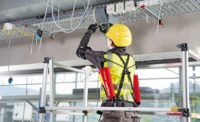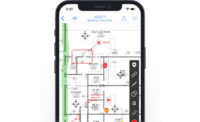
As one of the big names in power tools and concrete anchors, Hilti is a recognizable staple of of any concrete construction site. A global manufacturer based in Liechtenstein, the company has a long presence in North America. When it was announced in September 2019 that Hilti North America CEO Avi Kahn was promoted to the company’s executive board, it was also announced that his replacement was coming from within the organization.
Martina McIsaac, former head of Hilti Canada, takes the reins of Hilti North America at a time when the tool maker is pursuing a broad strategy of expanding its digital products and the connectivity of its products.
ENR: So it’s been a few months now since you became CEO of Hilti North America. What has it been like so far?
Martina McIsaac: It’s been a bit of a whirlwind. The really amazing thing about Hilti is how we do resource planning. Avi [Kahn] and I knew this would happen six months in advance, and he was my boss in Canada. I don’t know many companies that do resource planning for a hand-off like this—six months of shadowing him, it really feel seamless. But it’s a big construction market, and I’m still meeting engineering partners and suppliers.
ENR: Hilti has been reorganizing its North America office in recent years, relocating its headquarters to the Dallas, Texas, area from Tulsa, Okla. What are the main areas of growth for Hilti North America right now?
McIsaac: One of the greater advantages we have is we have a sole owner, the Hilti family trust. This means we can plan in long cycles, focus on forward thinking and invest in those plans. In our five-year strategy, the acceleration you see is that we're integrating into the entire customer workflow, not just offering a product. We’re expanding into software and services we were not in before. What you’re also seeing is the dynamism that comes with the current transformation of the industry. We are talking about BIM design, services management, jobsite management. It looks like it happened over night, but happened over years. We have over 400 people in Plano, Texas, the original headquarters in Tulsa has over 600 in our operations center. It is kind of a time for us to grow, to diversify.
ENR: So do you see Hilti placing a greater emphasis on providing services, rather than just tools?
McIsaac: For the industry at large, it’s all about the skilled labor shortage. We’ve heard some of our customers say “I'm turning down work," so jobsite productivity is the largest thing on the customer’s mind. Our largest customers may be investing in and looking for solutions themselves, but most customers are small entrepreneurs looking for solutions out there. At Hilti, we are a bit of a rarity being in so many segments of the industry. We can talk about fasteners, about tools, but can also help with planning and design and software. It’s a transformation for us internally. We are now looking at the whole application that the customer performs. We’re excited and we’re optimistic, and we see a lot of movement on bringing technology to jobsite.
ENR: Speaking of bringing more technology to the jobsite, Hilti has made several investments in tool-tracking, “smart” anchors and other Internet of Things technologies. Is that a growing segment for Hilti?
McIsaac: Customers are looking for safety and productivity. So an anchor that can talk to us in the future and tell what load is being put on it, and who installed it under what conditions is huge. For building lifecycles that kind documentation will be important. That anchor at World of Concrete was the first one, but we’re looking at the various use cases. If engineers and specifiers know that that anchor can provide that data, it’s very powerful. And tools can talk to us if we listen. They can say they need maintenance, that they won’t survive to next break without being serviced. So in an environment with a labor shortage, anything that can improve uptime is useful.
ENR: What is the future of Hilti’s digital strategy? The company has already invested in BIM for specifiers and designers, do you see that expanding?
McIsaac: In the company overall, BIM is where we’re seeing the biggest growth in our software development. There’s now an excitement over simple tools for digital layout. A few years ago, people were intimidated, but now you have a job that took two people two days takes one person two hours. We’re going to continue to invest in the models, and facilitate sharing of data between trades. We want to be in at the starting point of the BIM model. There is some BIM expertise among some of our customers, but some are looking for a partner to help them along. Until fairly recently many would get the BIM from the general contractor and convert to 2D, and do the work with string and chalk. But now some companies are requiring BIM for their subcontractors, and the model is being developed out to a different level than in the past.
ENR: Hilti has also expanded its asset management and tracking offerings. How is Hilti going to set itself apart in an increasingly crowded field of tracking services out there?
McIsaac: My experience with tracking assets is the customer’s biggest problem is they has too many of them. Our asset management system will track everything: ladders, buckets, not just Hilti tools. But we can reduce the number of tools they need by 30%, I will sell you fewer tools but track them accurately. It’s about reducing waste in the construction industry. And then you add in that our system can track more than just assets, it can track certifications and maintenance, it can reduce rental costs because you know return rentals on time. From the safety and workforce management perspective it makes sense. But we recognize it’s a big training and change program for our customers.
ENR: Any final thoughts on how Hilti is adapting to a changing construction industry?
McIsaac: If we back up and look at construction, it has lagged other industries in productivity. We have a shortage of skilled labor, and need to pull talent in from many many pools. these forces are moving our customer faster than ever into new technology spaces. You think about job where you swing a hammer and now you’re operating a robot, those are two very different jobs. We have to make this industry exciting to attract talent, and there are all these jobs in construction that didn’t exist three to five years ago. So Hilti’s commitment is to use our breadth of knowledge to help companies make that jump.






Post a comment to this article
Report Abusive Comment